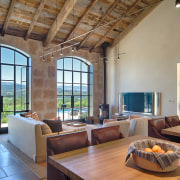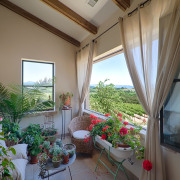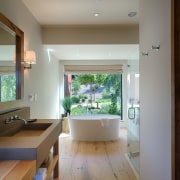New rural home is designed to look like a renovated winery with a modern addition
The two-storey main home is stone-clad like a traditional 1800s winery and is separated from the more contemporary guest wing by a breezeway

It's one thing to copy a traditional style, but something totally different to recreate a passage of time. That's the guiding principle and philosophy designer Julian Cohen brought to this home he designed in North California wine country.
For Cohen, it's important that clients first identify what's meaningful for them and, in this instance, he aimed to produce a home that tells a story and expresses a sense of history.
What emerged from early discussions was the influence on the owners of a stone building that was one of California's first wineries and a haiku the owners wrote.
"We wanted to establish what's really important to them, so their house could be an expression of who they are something they would feel totally comfortable with.
"These gave the essence from which we developed the design of their home."
What evolved in the design process was an L-shaped configuration of two buildings connected by a breezeway.
The stone-clad main building appears to be an 1800s winery which has been renovated and converted to a home at some stage. The secondary building referred to as the annex is a more modern single-storey structure that looks as if it is a recent addition to the property.

With this backstory established, Cohen was then able to set about the design and detailing that supported it. Getting the stone right on the two-storey building proved particularly challenging.
"We visited the inspirational winery, and the exterior stone used there was very large. And to look right, the stones have to become smaller higher up," says Cohen.
"It took three months searching to find a quarry to cut the stone then we experimented for weeks with grout materials."
Windows and doors were all custom-made in steel. Concrete posts were poured in place and needed to be precisely formed for the windows to fit into them with a tolerance of only 3mm.
Inside, flooring and ceiling boards were deliberately selected to give an aged character in keeping with an old winery building.
But once inside more contemporary elements are revealed. For example, the kitchen is characterised by two 150 x 150cm islands.
"The room is so big, one island would have been monstrous, so we broke it up" says Cohen. "But the butcher block look of the tops still gives a link to the past.
"There's also a full-on scullery, which is like a second kitchen, except there's no stove. With the scullery, we didn't need so many cabinets in the main kitchen, this resulted in a more European look."
The transition to a more modern look continues from the main building through the breezeway, to the annex. This is a self-contained guest wing with two bedrooms, ensuites and laundry.
The annex is clad in Alaskan yellow cedar and, in further contrast to the stone building, all its guttering and downpipes are concealed.
Solar panels on the roofs of the single-storey buildings supply most of the electricity the house needs. Cohen says while energy efficiency was important, it wasn't a driving force behind the design.
However, the house has most of its window expanse on the more sheltered north face, and shades have been added to any exposed windows. The main house also benefits from radiant heat from the slab floor, and there's a multi-split system for heating and cooling.
But for Julian Cohen the ultimate success of his design lies in the responses given by visitors to the property.
"Some people believe this really is a renovated old winery which is exactly what we were aiming for," he says.
Credit list
Architectural and interior design
Kitchen designer
Drafting
Pool
Structural engineer
Roofing
Flooring
Wallcovering
Lighting
Kitchen cabinetry
Countertop and spashback
Taps
Bath
Basin
Toilet
Interior furnishings
Builder
Landscape
Cabinet company
Cladding
Wood ceilings, beams and annex floor boards
Paints
Heating
Kitchen islands
Sink
Bathroom vanity
Story by: Paul Taylor
Photography by: Tim Maloney
Home kitchen bathroom commercial design
Connected to the ocean
Masculine meets mixed use
Contrast and connection
Home Trends Vol. 32/1
This latest edition of myTrends HOME has a strong emphasis on openness – homes that open to the view, indoor-outdoor flo...
Read More













